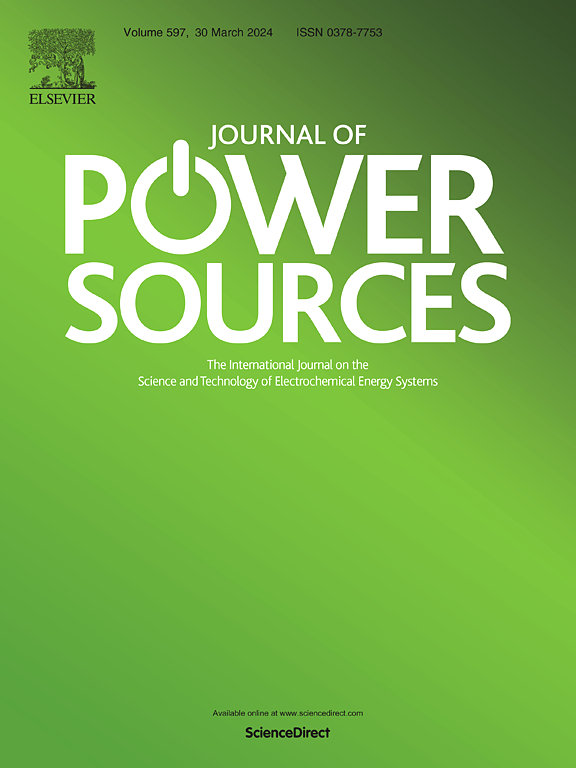Cross-linked interfacial network obviously enhancing energy storage property of semi-alicyclic polyimide-based dielectric nanocomposites
IF 8.1
2区 工程技术
Q1 CHEMISTRY, PHYSICAL
引用次数: 0
Abstract
The energy storage performance of polyimide film capacitor is poor in high temperature and high field environment because the conjugated π bond of aromatic structures produces excited electron and provides a channel for the movement of free electrons. In this paper, semi-alicyclic polyimide-based BaTiO3 nanocomposites (POSS@BT/PIS1) are designed and synthesized via combining molecular engineering with cross-linked interfacial engineering. The integration of non-coplanar dicyclohexyl units into the polyimide framework substantially diminishes molecular conjugation and increases the band gap. The polar functional group -SO2- induces a significant inductive effect, altering the direction of electron movement within the aromatic ring. This leads to the formation of localized deep traps and consequently inhibits carrier transport. Furthermore, BaTiO3 nanoparticles covered by polyhedral oligosiloxane (POSS) with epoxy group are added into the semi-alicyclic polyamide acid by solution blending method. After high temperature imide processing, a hybrid covalent cross-linked network is constructed to promote the increase of dielectric constant and breakdown strength. As a result, discharge energy density (Ue) of 10.82 J cm−3 and an efficiency (η) of 88 % are obtained in 1 wt% POSS@BT/PIS1. More importantly, 1 wt% POSS@BT/PIS1 deliveries the Ue of 6.9 J cm−3 and η of 80 % at 150 °C.
交联界面网络明显增强了半脂环聚酰亚胺基介电纳米复合材料的储能性能
聚酰亚胺薄膜电容器在高温高场环境下的储能性能较差,这是因为芳香族结构的共轭π键产生受激电子,为自由电子的运动提供了通道。本文采用分子工程和交联界面工程相结合的方法,设计合成了半脂环聚酰亚胺基BaTiO3纳米复合材料(POSS@BT/PIS1)。非共面双环己基单元集成到聚酰亚胺框架中大大减少了分子共轭并增加了带隙。极性官能团- so2 -引起了显著的感应效应,改变了芳环内电子的运动方向。这导致局部深圈闭的形成,从而抑制载流子的运输。在此基础上,采用溶液共混的方法,将环氧基多面体低聚硅氧烷(POSS)包覆的BaTiO3纳米粒子加入到半脂环聚酰胺中。亚胺经高温处理后,形成了杂化共价交联网络,促进了介电常数和击穿强度的提高。结果表明,在1 wt% POSS@BT/PIS1条件下,放电能量密度(Ue)为10.82 jcm−3,效率(η)为88%。更重要的是,在150°C时,1 wt% POSS@BT/PIS1的Ue为6.9 jcm−3,η为80%。
本文章由计算机程序翻译,如有差异,请以英文原文为准。
求助全文
约1分钟内获得全文
求助全文
来源期刊

Journal of Power Sources
工程技术-电化学
CiteScore
16.40
自引率
6.50%
发文量
1249
审稿时长
36 days
期刊介绍:
The Journal of Power Sources is a publication catering to researchers and technologists interested in various aspects of the science, technology, and applications of electrochemical power sources. It covers original research and reviews on primary and secondary batteries, fuel cells, supercapacitors, and photo-electrochemical cells.
Topics considered include the research, development and applications of nanomaterials and novel componentry for these devices. Examples of applications of these electrochemical power sources include:
• Portable electronics
• Electric and Hybrid Electric Vehicles
• Uninterruptible Power Supply (UPS) systems
• Storage of renewable energy
• Satellites and deep space probes
• Boats and ships, drones and aircrafts
• Wearable energy storage systems
 求助内容:
求助内容: 应助结果提醒方式:
应助结果提醒方式:


